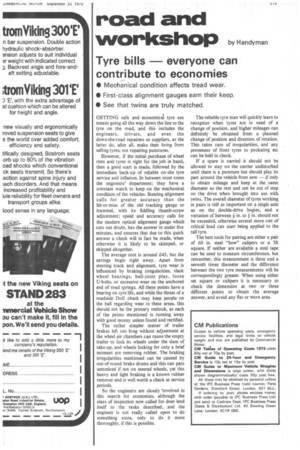road and
Page 213

If you've noticed an error in this article please click here to report it so we can fix it.
workshop by Handyman
Tyre bills — everyone can contribute to economies
• Mechanical condition affects tread wear.
• First-class alignment gauges earn their keep.
• See that twins are truly matched.
GETTING safe and economical tyre use means going all the way down the line to the tyre on the road, and this includes the engineers, drivers, and even the down-the-road repairers or suppliers, as the latter do, after all, make their living from selling tyres, not repairing punctures.
However, if the initial purchase of wheel rims and tyres is right for the job in hand, then a good start is made, followed by the immediate back-up of reliable on-site tyre service and inflation. In between must come the engineers' department; they have a constant watch to keep on the mechanical condition of the vehicles. Steering alignment calls for greater accuracy than the hit-or-miss of the old tracking gauge or trammel, with its fiddling thumb-screw adjustment; speed and accuracy calls for the modern optical alignment gauge which cuts out doubt, has the answer in under five minutes, and ensures that due to this quick answer a check will in fact be made, when otherwise it is likely to be skimped, or skipped altogether.
The average cost is around £45, but the savings begin right away. Apart from steering track and alignment, tyre wear is influenced by braking irregularities, slack wheel bearings, ball-joint play, loose U-bolts, or excessive wear on the anchored end of road springs. All these points have a bearing on tyre life, and while the threat of a roadside DoE check may keep people on the ball regarding wear in these areas, this should not be the primary outlook, as each of the points mentioned is running away • with good money unless found and rectified.
The rather simpler matter of trailer brakes left too long without adjustment at the wheel air chambers can cause the empty trailer to lock its wheels under the slam of take-up, and wheels locking for only a brief moment are removing rubber. The braking irregularities mentioned can be caused by out-of-round brake drums and this can pass unnoticed if not on steered wheels, yet this heavy and light braking is a known rubber remover and is well worth a check at service periods.
So the engineers are closely Involved in this search for economies, although the class of inspection now called for does lend itself to the tasks described, and the engineer is not really called upon to do something extra, only to do it more thoroughly, if this is possible. The reliable tyre man will quickly learn to recognize when tyres are in need of a change of position, and higher mileages can definitely be obtained from a planned change of position and direction of rotation. This takes care of irregularities, and any proneness of front tyres to pocketing etc can be held in check.
If a spare is carried it should not be allowed to stay on the carrier undisturbed until there is a puncture but should play its part around the vehicle from new — if only to obtain mileage and keep at the same diameter as the rest and not be out of step on the drive when brought into use with twins. The overall diameter of tyres working in pairs is still as important on a single axle as on the double-drive bogies, and a variation of between k in. to in. should not be exceeded, otherwise several more cwt of critical load can start being applied to the tall tyre.
The best tools for pairing are either a pair of 60 in. steel "bow" calipers or a 3ft square. If neither are available a steel tape can be used to measure circumference, but remember, this measurement is three and a seventh times diameter and the difference between the two tyre measurements will be correspondingly greater. When using either set square or calipers it is necessary to check the dimension at two or three different points to obtain the average answer, and avoid any flat or worn area.
































































































































































































































































































































































































































































































































